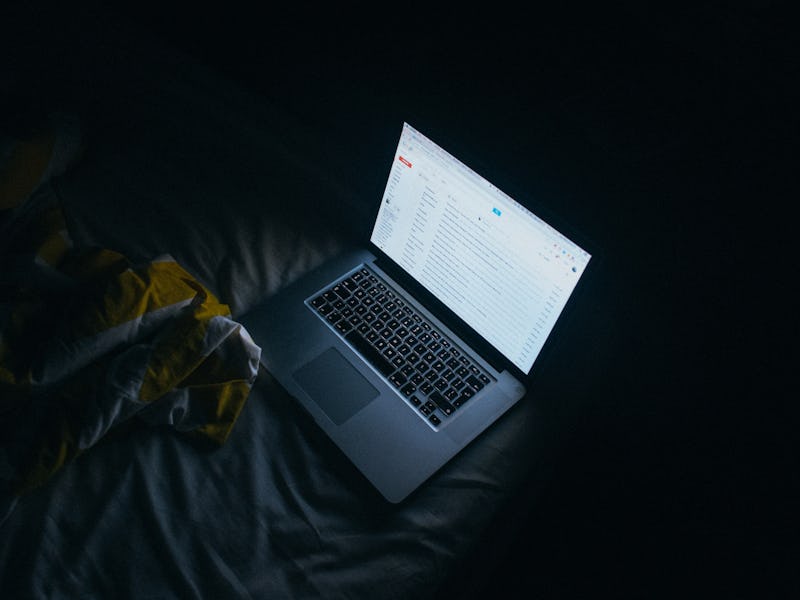No, blue light from your phone probably isn't making you age faster
Unless you're a fruit fruit fly exposed to a high dose over 12 hours, that is.

Blue light is just another unassuming band of waves in the visible light spectrum, but it’s caught a lot of flack in recent years as concern over our constant proximity to phones or computers — and their LED screens — continues to ramp up. This fear has led to some strange solutions, including cosmetic products like sunscreens to supposedly protect your skin against blue light’s harmful effects.
And research] published Thursday in the journal Aging and Mechanisms of Disease reveals findings that blue light exposure could accelerate aging too.
…well, if you’re a fruit fly exposed to high-doses of the stuff for 12 hours straight, that is.
Despite the largely technology-induced fear surrounding blue light, many of the results of such studies are either inconclusive or are found using experiments that don’t really reflect our daily experience. And this most recent fruit fly trial was no different.
In their experimental set-up, the study’s authors describe exposing different groups of fruit flies to three different light conditions:
- 24 hours of total darkness
- 12 hours of white light with a blue light filter, and 12 hours of darkness
- 12 hours of concentrated blue light, and 12 hours of darkness
The light intensities in these trials were measured using something called photon flux, which is essentially a measurement of how many light particles (aka photons) pass through an area each second. If you imagine these photons flowing out of our screens like water from a showerhead, the flux is how strongly the water flows.
But not all flux is created equal, and lead researcher Jaga Giebultowicz, Ph.D., professor of integrative biology at Oregon State University, told Inverse that the intensity of the blue light used in their study was much stronger than you’d find from your run-of-the-mill cellphone.
“The effects of phones on human cells can be more subtle and harder to detect,” said Giebultowicz.
In these different trials, Giebultowicz and her team found that the older flies exposed to the blue light appeared to be aging faster than their younger or non-blue light counterparts, as determined by their deteriorated movement after the trial.
Fruit flies reacted badly to prolonged exposure to blue light, but that doesn't necessarily mean humans will.
They also found that mutant, eyeless flies (yikes) still displayed negative effects after blue light exposure despite the light never entering their nonexistent retinas. The researchers were able to determine that the effects of the blue light had directly impacted the flies’ brains instead. As for how that happened, the research didn’t reveal a conclusive pathway or explanation.
However, while it was clear that the flies in these experiments had a rough time, it’s still unclear exactly how this would translate to humans and our blue light-emitting devices.
For one, while we do spend a lot of time on our devices, it’s unlikely that we spend up to 12 hours directly in front of them every day, or that they’re turned up bright enough or angled correctly to give us the full brunt of their light.
And speaking of brunt, the blue light that we can expect to receive from our devices isn’t really that strong anyway. When talking about how much light intensity is received from photon flux, which is measured in joules per square centimeter, researchers use a different measurement called irradiance. According to a blog post by chemistry Ph.D. and science educator Michelle Wong, the irradiance of light from our screens in past trials has only ever been measured as high as 9.7 microwatts per square centimeter. This is still considerably lower than levels during, say, summer in Texas which is around 5000 microwatts per square centimeter, according to a 2012 study in the Journal of Investigative Dermatology.
In order to reach damaging levels of intensity described in previous blue light studies, which Wong found used an average flux of 40 joules per square centimeter, users would have to spend weeks to months in front of their devices, which is clearly much longer than the 12 hours the flies endured.
That said, should you spend every waking hour in front of your screen? Probably not. But will it result in rapid aging if you do? Again, probably not.
Abstract:
Light is necessary for life, but prolonged exposure to artificial light is a matter of increasing health concern. Humans are exposed to increased amounts of light in the blue spectrum produced by light-emitting diodes (LEDs), which can interfere with normal sleep cycles. The LED technologies are relatively new; therefore, the long-term effects of exposure to blue light across the lifespan are not understood. We investigated the effects of light in the model organism, Drosophila melanogaster, and determined that flies maintained in daily cycles of 12-h blue LED and 12-h darkness had significantly reduced longevity compared with flies maintained in constant darkness or in white light with blue wavelengths blocked. Exposure of adult flies to 12 h of blue light per day accelerated aging phenotypes causing damage to retinal cells, brain neurodegeneration, and impaired locomotion. We report that brain damage and locomotor impairments do not depend on the degeneration in the retina, as these phenotypes were evident under blue light in flies with genetically ablated eyes. Blue light induces expression of stress-responsive genes in old flies but not in young, suggesting that cumulative light exposure acts as a stressor during aging. We also determined that several known blue-light-sensitive proteins are not acting in pathways mediating detrimental light effects. Our study reveals the unexpected effects of blue light on fly brain and establishes Drosophila as a model in which to investigate long-term effects of blue light at the cellular and organismal level.